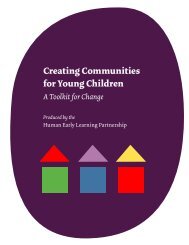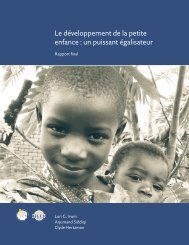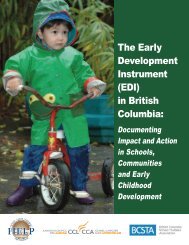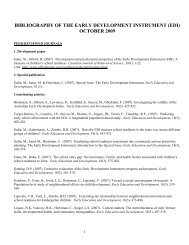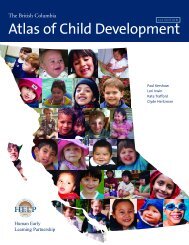Total Environment Assessment Model for Early Child Development
Total Environment Assessment Model for Early Child Development
Total Environment Assessment Model for Early Child Development
Create successful ePaper yourself
Turn your PDF publications into a flip-book with our unique Google optimized e-Paper software.
<strong>Total</strong> <strong>Environment</strong> <strong>Assessment</strong> <strong>Model</strong><br />
<strong>for</strong> <strong>Early</strong> <strong>Child</strong> <strong>Development</strong><br />
outcomes <strong>for</strong> children are those in which<br />
disadvantaged children are developmentally<br />
stronger than disadvantaged children in other<br />
nations, whereas, in all nations, children at<br />
the higher ends of the socioeconomic spectrum<br />
tend to demonstrate relatively strong<br />
outcomes.<br />
In this report we provide a framework <strong>for</strong><br />
understanding the environments (and their<br />
characteristics) that play a significant role in<br />
providing nurturant conditions to all children<br />
in an equitable manner. The framework acts<br />
as a guide to understanding the relationships<br />
between these environments, putting the<br />
child at the center of her or his surroundings.<br />
The environments are not hierarchical,<br />
but rather are interconnected. At the most<br />
intimate level is the family environment. At<br />
a broader level are residential communities<br />
(such as neighbourhoods), relational communities<br />
(such as those based on religious<br />
or other social bonds), and the ecd service<br />
environment. Each of these environments<br />
(where the child actually grows up, lives, and<br />
learns) is situated in a broad socioeconomic<br />
context that is shaped by factors at the<br />
regional, national, and global level.<br />
The framework affirms the importance of<br />
a lifecourse perspective in decision-making<br />
regarding ecd. Actions taken at any of these<br />
environmental levels will affect children<br />
not only in present day, but also throughout<br />
their lives. The framework also suggests that<br />
historical time is critically influential <strong>for</strong><br />
children; large institutional and structural<br />
aspects of societies (e.g., government policyclusters<br />
and programs) influence ecd, and<br />
these are “built” or “dismantled” over long<br />
periods of time.<br />
Socioeconomic inequities in developmental<br />
outcomes result from inequities in the<br />
degree to which the experiences and environmental<br />
conditions <strong>for</strong> children are nurturant.<br />
Thus, all recommendations <strong>for</strong> action stem<br />
from one overarching goal: to improve the<br />
nurturant qualities of the experiences children<br />
have in the environments where they grow up,<br />
live, and learn. A broad array of experiences<br />
and environmental conditions matter. These<br />
include those that are intimately connected<br />
to the child, and there<strong>for</strong>e readily identifiable<br />
(e.g., the quality of time and care provided by<br />
parents, and the physical conditions of the<br />
child’s surroundings), but also more distal<br />
factors that in various ways influence the<br />
child’s access to nurturant conditions (e.g.,<br />
whether government policies provide families<br />
and communities with sufficient income and<br />
employment, health care resources, early<br />
childhood education, safe neighborhoods,<br />
decent housing, etc.).<br />
While genetic predispositions and biophysical<br />
characteristics partially explain how<br />
environment and experience shape ecd, the<br />
best evidence leads us to consider the child as<br />
a social actor who shapes and is in turn shaped<br />
by his or her environment. This is known as<br />
the “transactional model,” which emphasizes<br />
that the principal driving <strong>for</strong>ce of child<br />
development is relationships. Because strong<br />
nurturant relationships can make <strong>for</strong> healthy<br />
ecd, socioeconomic circumstances, despite<br />
their importance, are not fate.<br />
The family environment is the primary<br />
source of experience <strong>for</strong> a child, both because<br />
family members (or other primary caregivers)<br />
provide the largest share of human contact<br />
with children and because families mediate a<br />
child’s contact with the broader environment.<br />
Perhaps the most salient features of the family<br />
environment are its social and economic<br />
resources. Family social resources include<br />
parenting skills and education, cultural practices<br />
and approaches, intra-familial relations,<br />
and the health status of family members.<br />
Economic resources include wealth, occupational<br />
status and dwelling conditions.<br />
The gradient effect of family resources on<br />
ecd is the most powerful explanation <strong>for</strong><br />
differences in children’s well-being across<br />
societies. Young children need to spend their<br />
time in warm responsive environments that<br />
protect them from inappropriate disapproval<br />
and punishment. They need opportunities to<br />
explore their world, to play, and to learn how<br />
to speak and listen to others. Families want to<br />
provide these opportunities <strong>for</strong> their children,<br />
but they need support from community and<br />
government at all levels.<br />
<strong>Child</strong>ren and their families are also shaped<br />
by the residential community (where the<br />
child and family live) and the relational<br />
communities (family social ties to those<br />
with a common identity) in which they<br />
Executive<br />
Summary



